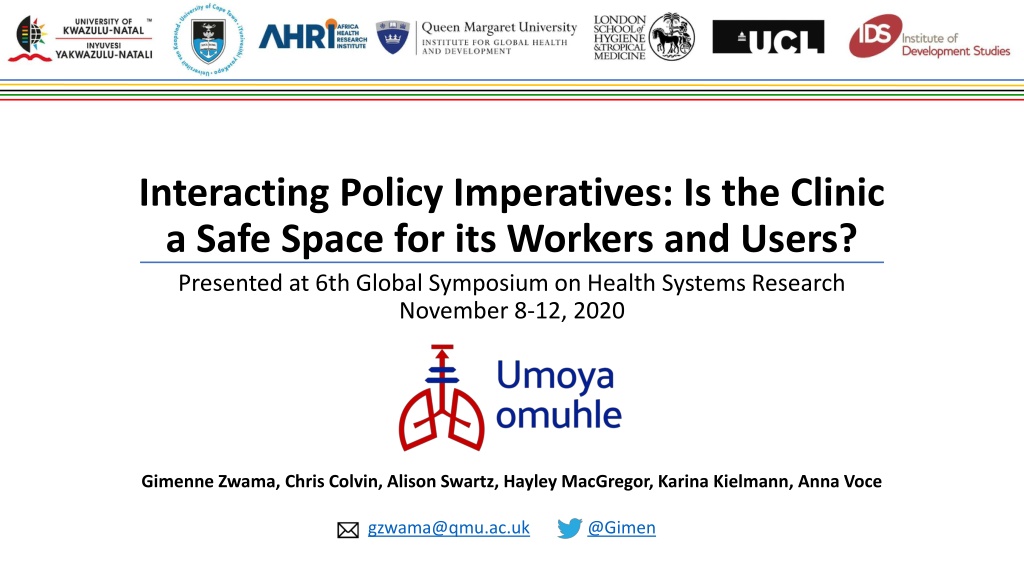Enhancing Clinic Safety: Interplay Between Ideal Clinic Initiative and TB-IPC Policy Imperatives
The Ideal Clinic Initiative (ICI) in South Africa aims to improve health system quality by addressing operational challenges. This study explores the interaction between ICI components and TB infection prevention and control (TB-IPC) measures in primary health care facilities. Findings reveal compromised ICI implementation impacting TB transmission risks, such as increased patient movement and incomplete policy interpretation. These challenges highlight the need to optimize clinic safety through effective integration of ICI and TB-IPC interventions.
Download Presentation

Please find below an Image/Link to download the presentation.
The content on the website is provided AS IS for your information and personal use only. It may not be sold, licensed, or shared on other websites without obtaining consent from the author. Download presentation by click this link. If you encounter any issues during the download, it is possible that the publisher has removed the file from their server.
E N D
Presentation Transcript
Interacting Policy Imperatives: Is the Clinic a Safe Space for its Workers and Users? Presented at 6th Global Symposium on Health Systems Research November 8-12, 2020 Gimenne Zwama, Chris Colvin, Alison Swartz, Hayley MacGregor, Karina Kielmann, Anna Voce gzwama@qmu.ac.uk @Gimen
Introduction The South African National Department of Health introduced the Ideal Clinic Initiative (ICI) in 2016 as a health system strengthening intervention to re-organise, integrate and improve the quality of care. It is aimed to address operational issues such as: Vertical and fragmented service delivery, i.e. needing separate facility visits for ANC, HIV care, EPI and NCD services Overcrowding and inefficient patient flows Poor quality and multiple clinical records per patient, hindering continuity of care Within the context of high TB prevalence, the interaction between ICI components and recommended TB-IPC interventions requires investigation Methods Desktop review to identify ICI components and recommended TB-IPC interventions Immersive ethnographic methods (3-6 days per facility) At four primary health care facilities in KwaZulu-Natal, South Africa To examine the interactions between ICI and TB-IPC policy imperatives
Findings | Desktop Review ICI components: TB-IPC measures (SANDoH 2015): Centralised filing system/single administrative point Appointments scheduling by day and 2-hr time slot, with pre-appointment retrieval of patient clinical records Reorganisation of patient flow based on streams of care (i.e. Acute, Maternal and Child Health, Chronic (includes TB)) Each stream with its own designated waiting area, vital signs station, and consulting room(s) Integrated care: patient receives all required services in one visit Administrative measures: cough triaging, TB symptom screening, (presumptive) TB patient separation or isolation Environmental measures: ventilation systems e.g. opening windows and doors Personal protective measures: wearing of surgical masks by clinic users and N95 respirators by healthcare workers Managerial measures: facility specific TB-IPC plan and TB-IPC champion
Findings | Clinic Ethnographies ICI implementation is compromised by: Implications of compromised ICI implementation for TB-IPC and TB transmission risk: Increased waiting times and sharing of waiting areas by different types of patients to collect their file, or for their vital signs to be taken Increased patient movement, e.g. to drop off file and make appointment Number of facility workers and time that they are exposed to undiagnosed or confirmed TB patients who still need to be initiated on treatment or experience treatment challenges Previous programmatic service delivery, which has influenced: Existing clinic building infrastructure and current resourcing of health care facilities Organisation of space: physically segregated services Organisational culture Piecemeal, partial implementation, e.g. day appointments, and no pre-appointment retrieval of files Incomplete interpretation of the policy
Discussion Like TB-IPC implementation at health facility level (HSR 2020, Voce et al.), ICI implementation is influenced by local variations in clinic infrastructure, organisation of space, organisational culture and resources Effective implementation of policies for health system strengthening and of guidelines for improving programme effectiveness requires: An analysis of interacting imperatives A concerted response to shared implementation opportunities and hindrances Movement and number of workers and users Time spent together by different types of workers and users Ideal Clinic Initiative implementation Organisation and location of service delivery points Present clinic infrastructure and organisational culture TB-IPC implementation Conclusion The alignment of TB-IPC guidelines and ICI policy as well as the integration of their implementation are unexploited opportunities.
The support of the Economic and Social Research Council (UK) is gratefully acknowledged. This project is partly-funded by The Antimicrobial Resistance Cross Council Initiative supported by the seven research councils in partnership with other funders. This project contributes to the GCRF challenge areas of Equitable Access to Sustainable Development and Good Governance and Social Justice by promoting locally appropriate, systems-based approaches to sustainable health and wellbeing for both patients and health workers in South African health facilities.























